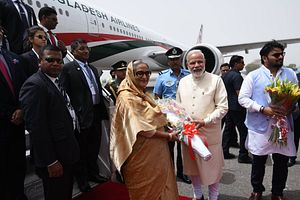After being deferred twice in the past few months, Bangladesh’s Prime Minister Sheikh Hasina is in India this week. This visit, Hasina’s first state visit in seven years, has been long in the making and New Delhi is hoping to showcase it as an important part of its neighborhood policy. Breaking protocol, Indian Prime Minister Narendra Modi went to the airport to receive Hasina personally, thereby underscoring the importance New Delhi is attaching to the visit. Since coming to office in May 2014, the Modi government has made the immediate neighborhood a top priority. Despite the failure of its initial outreach to Pakistan, India’s engagement with other neighbors like Sri Lanka and Bangladesh have been more productive.
After waiting for more than four decades, India and Bangladesh exchanged 162 enclaves in June 2016, implementing the landmark Land Boundary Agreement.
India handed over 51 enclaves, comprising 7,110 acres to Bangladesh; and Bangladesh gave India 111 enclaves comprising around 17,160 acres. Modi invested considerable political capital in sorting out the contentious issue. The previous summer, while on a visit to Bangladesh, Modi announced a $2 billion line of credit for developing the neighboring country. India also agreed to increasing the power supply from India to Bangladesh from 500 MW to 1,100 MW within two years.
Hasina announced two special economic zones in Mongla and Bheramara for India, aimed at luring economic investment. Two bus services — Kolkata-Dhaka-Agartala and Dhaka-Guwahati-Shillong — were launched to enhance connectivity between the two neighbors. Delhi and Dhaka also “pledged zero tolerance towards terrorism and extremism.” Since then, terror cooperation has intensified between the two states with Bangladesh taking serious steps in dealing a decisive blow to separatist Indian insurgent organizations like Ulfa and the National Democratic Front of Bodoland. The Bangladesh Nationalist Party had taken a softer line against such groups, allowing them to operate from Bangladesh’s territory with impunity despite repeated Indian concerns. Hasina’s Awami League government has been more solicitous of Indian concerns and better institutional modalities have evolved over the years to share intelligence. There is now greater convergence between India and Bangladesh on dealing with fundamentalist forces like the HuJi, the JMB and Harkat-ul-Ansar.
West Bengal Chief Minister Mamata Banerjee, who had refused to accompany former Prime Minister Manmohan Singh during his visit to Bangladesh in September 2011, joined Modi for his 2015 visit, raising expectations that Delhi and Dhaka might even be able to move forward on an accord on Teesta River water sharing — an issue that has been held up by West Bengal’s concerns. But with political relations between Modi and Banerjee at an all time low, Delhi is not hopeful of concluding a deal on sharing Teesta water any time soon. Negotiations on Teesta have been ongoing for almost two decades.
A pact on Teesta river water would have been a key victory for Hasina but in its absence, New Delhi will try to put its best foot forward. There are some reports suggesting that India is likely to give Bangladesh a credit line of at least $3.5 billion for infrastructure projects during Hasina’s visit. Even if India goes through with this, it would just be a fraction of the $20 billion in low-cost loans for infrastructure projects Chinese President Xi Jinping’s pledged last year. China’s grip on Bangladesh is tightening despite Hasina’s friendly overtures to India. India is, therefore, keen on signing a defense pact with Dhaka to wean it away from its overdependence on China. China is Bangladesh’s biggest defense supplier. India ideally would like a comprehensive defense pact encompassing training, sale of military hardware, and military-to-military cooperation. But such a defense pact might be politically difficult for Hasina to sell domestically.
Hasina will also be visiting against the backdrop of a fresh surge in Islamic State-linked attacks across the country. Bangladesh is witnessing a new wave of violent religious polarization after the 2013 Shahbagh protest movement, when the Hasina government’s decision to execute war criminals from 1971 was met with virulent opposition from the Jamaat-e-Islami (JeI). Since then radical forces have tried to put up a united front. The attack on a popular cafe in Dhaka’s Gulshan area on July 1 last year led to the massacre of more than 20 hostages, most of them foreigners. Suicide bombings are on the rise in the country and the Hasina government is intent on taking strong action against provocateurs.
Bangladesh has been voicing its concerns about the terrorism problem in South Asia almost as vociferously as India. It joined India in boycotting the South Asian Association for Regional Cooperation meeting last year, which was set to be held in Pakistan. It has taken a lead in marginalizing Pakistan by joining the Bay of Bengal Initiative for Multi-Sectoral Technical and Economic Cooperation (BIMSTEC) and the Bangladesh, Bhutan, India, Nepal (BBIN) Initiative. In order to enhance regional connectivity, New Delhi has decided to dredge the Brahmaputra river from Sadia in Assam to Chittagong port in Bangladesh. This Brahmaputra National Waterway-II will have direct access to Chittagong port of Bangladesh and Haldia port of West Bengal and consequently will boost trade with Southeast Asian nations.
It is important for India to get Bangladesh right. Delhi should be sensitive to its concerns and priorities at a time when Dhaka under Hasina has been a votary of strong Indo-Bangladesh ties. Hasina herself has taken great political risks to restore momentum in bilateral ties since 2008. A moderate, secular, stable Bangladesh will go a long way in stabilizing South Asia. India, being the bigger and economically more powerful of the two, can and should take the lead in this process by taking generous and constructive steps to improve relations with Bangladesh. If India wants to retain its primacy in South Asia, it will have to change its regional economic and foreign policies by pursuing a forward looking agenda with like-minded smaller neighbors like Bangladesh. Hasina’s visit is likely to reinforce this message.

































